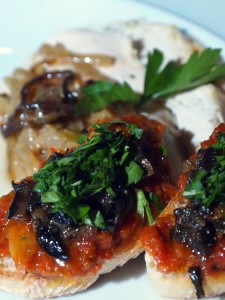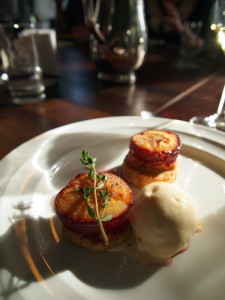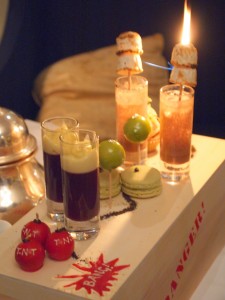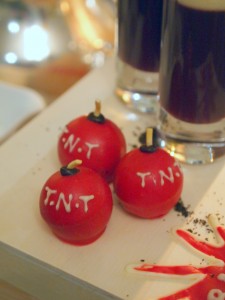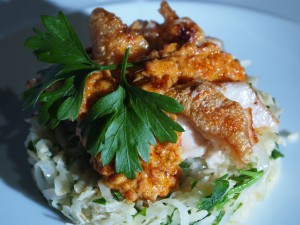A discussion about the Elizabeth David books that inspired last week’s Poulet Antiboise got me thinking about Christmas presents. I love a food book that’s capable of making me salivate at the writing as well as over the recipes, and there’s nothing better than a book that rewards dipping in and out as much as it does reading from cover to cover. (B, K and L, look away now – you may be receiving presents from this list this year.)
So I’ve made a short list below of some of my very favourite books in this genre. Most aren’t the Jamie-Gordon-Nigella sort that you’ll find displayed in your local bookshop for Christmas; those folk get enough marketing help as it is. Each of these books has something out of the ordinary about it; I hope you enjoy them as much as I do.
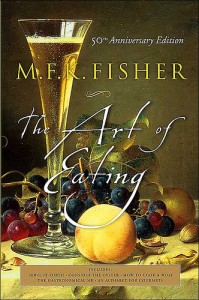
The Art of Eating M.F.K. Fisher (1908-1992) was an American gastronome and prolific author absolutely preoccupied with food; she’s considered the creator of food writing as a specific genre. Her writing is full of an immense love of life, art and the joy of food; eating it, preparing it, growing it, travelling vast distances to find it, and sharing it; all without a trace of the food snobbism that infuses such a lot of later writing on the subject. Her style is so conversational and so engaging that to read her can feel like sitting over a pot of tea and gingerbread (or a bottle of champagne and some oysters), nattering away as you chew. Five of her very best books of essays: Serve it Forth, Consider the Oyster, How to Cook a Wolf, The Gastronomical Me and An Alphabet for Gourmets, are collected in this fat 50th anniversary edition. Unfortunately, and unconscionably, the book is out of print in the UK, but second-hand copies are still to be had for a sensible price on Amazon Marketplace in hard- and soft-back editions. If the book-lover in your life cares more about what’s inside the covers (as she should) than whether the corners are a bit bent, she’ll thank you for this. It’s a book to be dipped into – a wonderful bedside companion, with occasional trips down to the kitchen to try out some of the recipes scattered through it.
Here are Mary Frances’ opening paragraphs on snails. How could you not want to spend 750 pages in this lady’s company?
I have eaten several strange things since I was twelve, and I shall be glad to taste broiled locusts and swallow a live fish. But unless I change very much, I shall never be able to eat a slug. My stomach jumps alarmingly at the thought of it.
I have tried to be callous about slugs. I have tried to picture the beauty of their primeval movements before a fast camera, and I have forced myself to read in the Encyclopaedia Britannica the harmless ingredients of their oozy bodies. Nothing helps. I have a horror, deep in my marrow, of everything about them. Slugs are awful, slugs are things from the edges of insanity, and I am afraid of slugs and all their attributes.
But I like snails. Most people like snails.
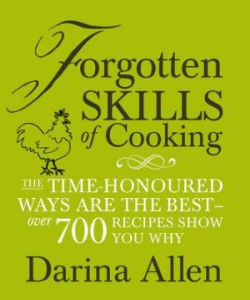
Forgotten Skills of Cooking I bought Darina Allen’s latest book after spending the afternoon with her back in October; it’s the only book in this list to be published this year. Your gift recipient probably has a few shelves groaning under the weight of cookery books, many of them full of broadly similar recipes and techniques. He is very unlikely to have anything like this one. Forgotten Skills is full of the recipes your great-grandmother was making before mechanisation and processing; here, you’ll learn to make your own butter, yoghurt, black pudding, gorse wine, preserved meats, smoked fish, cheeses – it’s by far the most exciting cookery book I’ve seen this year, and deservedly won 2010’s André Simon prize. There’s more to this book than recipes; you’ll learn about raising chickens; building smokers; judging the tenderness of a freshly shot bunny; and jointing, trussing, boning and plenty of other butchery and husbandry skills.
For more on Darina and her cookery school at Ballymaloe, see this post from last month.
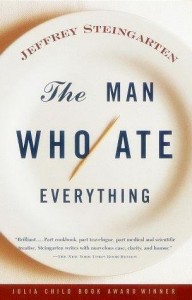
The Man Who Ate Everything and It Must’ve Been Something I Ate Jeffrey Steingarten’s writing was, back in 2005, one of the things that encouraged me to move away from educational publishing and start writing about food instead; here was someone treating food writing in a way which somehow achieved the magic combination of being blithe and hilariously funny at the same time as being considered and near-scholarly. He was American Vogue’s food correspondent, and his lucid, witty and punctilious approach to eating is a joy. “I like salad, eaten in moderation like bacon or chocolate, about twice a week.” Here, you’ll inhale the fumes of carbonised pizza through Steingarten’s pages as he tries to hack his home oven to reach the temperatures of a commercial pizza oven; learn that the air in Alsace is “as crisp as bacon and as sweet as liver sausage”; discover exactly what Joël Robuchon’s recipe for chips is; and find yourself in possession of useful photocopiable pages on Venetian seafood vocabulary for your next holiday. These books are cheering, life-enhancing and, for the committed foodie, almost as much fun as eating. Buy yourself a copy too.
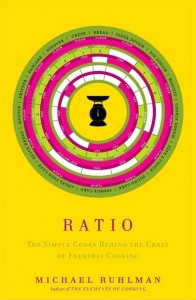
Ratio: The Simple Codes Behind the Craft of Everyday Cooking Michael Ruhlman’s little book is based on a very simple premise: that of the chef’s database. If you’ve ever worked in a restaurant kitchen you’ll probably be familiar with the giant spreadsheet which tots up food costs, helps with menu planning, sub-dishes and aids in ordering. The useful part of such a database for the home cook, and the part that Ruhlman is concerned with here, is the breakdown of basic recipes – cake batters, bread doughs, all kinds of pastry, cookie and biscuit and so forth – into the ratios of ingredients that go to make them up. Adjust the ratios, and your bread dough becomes a pasta dough; your set custard a crème Anglaise. Alongside the elemental recipes you’ll find examples of ways to expand them (so that set custard and a pastry dough become a fine asparagus quiche), with encouragement to expand on these ideas and experiment yourself. It’s a very useful little book that lives on my desk rather than in the kitchen.
Ruhlman’s webpage points you at the inevitable iPhone app associated with the book. I haven’t played with it yet, but it looks jolly if you are not the sort to get upset about a phone caked in batter.

They Can’t Ration These This book is for the forager in your life, who should already own Richard Mabey’s little pocket-sized Collins Gem edition of Food for Free (only £2.50 on Amazon at the time of writing – go and grab a copy). The Vicomte de Mauduit was writing in the Second World War, when foraging had become something of a necessity rather than the jolly middle-class weekend yomping exercise it is these days. (And no bad thing, that; as the Vicomte says, “And when Peace will again come on Earth, the people of Britain, already made conscious through food rationing that meals no longer consist of a hot and then cold “joint with two veg”, will find this book a practical and valuable guide to better things”.) The recipes and foraging tips are alternately delicate and delicious-sounding – faux-capers made from nasturtium buds, beechnut butter, the tips of hops treated like asparagus – and the sort of thing that you would only go near in extremis; the starling, frog and hedgehog recipes can probably be left well alone in these fat years of the 21st century. I am depressed to learn that Mauduit was captured by the Nazis after the fall of France, and disappeared in Germany; I hope he’s looking down on us from whatever cloud Sydney Smith and his trumpets are parked on, stuffing his face with foie gras accompanied by those lovely-sounding nasturtium buds and some rowan jelly.
This is a simply beautiful edition from the Persephone Press, whose output is really worth getting to know if you love books. It’s one of those books as lovely to look at and handle as it is to read. I was particularly taken with the endpapers (when do you ever have occasion to say that?), which are absolutely in the spirit of the rest of the book, taken from a fabric design in potato-print made on sugar paper in paint from 1940.

The Oxford Companion to Food My lovely mother-in-law gave me a copy of this hefty encyclopaedia of food earlier this year, and I’ve been dibbling in and out of it ever since. Unusually for a reference book, this is an occasionally opinionated and often very funny treatment of its subject; it’s also exhaustive and enjoyably comprehensive. Did you know that the long bones of the giraffe do not yield good marrow, or that its tongue is the only eatable part of the beast? That the mahseer is the most famous angling fish of India? That if you buy fish in a Finnish market, you’ll be given a free bunch of dill?
There’s something on nearly every page here which is new to me, or which I only know the barest outlines about: Babylonian cookery, an 18th century portable soup for travellers (a sort of precursor of the stock cube for the upper sets), the brief Victorian fashion for something called paper bag cookery. There’s room on everyone’s shelf for a book like this, which has the potential to entertain you just as much as it educates.

